Businesses in the water supply, sewerage, waste management and remediation sector
Data extracted in February 2024
Planned article update: February 2025
Highlights
The water supply, sewerage, waste management and remediation activities sector accounted for 79 700 enterprises in the EU in 2021 and generated €290.5 billion of net turnover.
The water supply, sewerage, waste management and remediation activities sector employed 1.6 million people in the EU in 2021.
This article presents information relating to the European Union's (EU) water supply, sewerage, waste management and remediation activities, as covered by NACE Rev. 2 Section E. It belongs to a set of statistical articles on 'Business economy by sector'.
Full article
Structural profile
There were almost 79 700 enterprises classified within the EU's water supply, sewerage, waste management and remediation activities sector (Section E) in 2021, an increase of 2.1 % compared with 2020. These enterprises employed 1.6 million persons, 2.4 % less than the previous year. They generated €107.0 billion of value added, 4.7 % more than in 2020 and €290.5 billion of net turnover, 13.5 % more than in 2020.
Enterprises in the water supply, sewerage, waste management and remediation activities sector were, on average, relatively large, as they contributed only with 0.3 % of the total number of enterprises in the EU's business economy (Sections B to N and P to R, as well as Divisions S95 and S96) in 2021, and accounted for only 0.05 % of its employment and 0.8 % of its value added. Compared with the other NACE sections within the business economy, the water supply, sewerage, waste management and remediation activities sector was the second smallest in terms of its number of enterprises, as only mining and quarrying employed fewer persons. In terms of employment it was the fourth smallest in 2021, ahead of repair of computers and personal and household goods, the mining and quarrying sector and electricity, gas, steam and air conditioning supply.
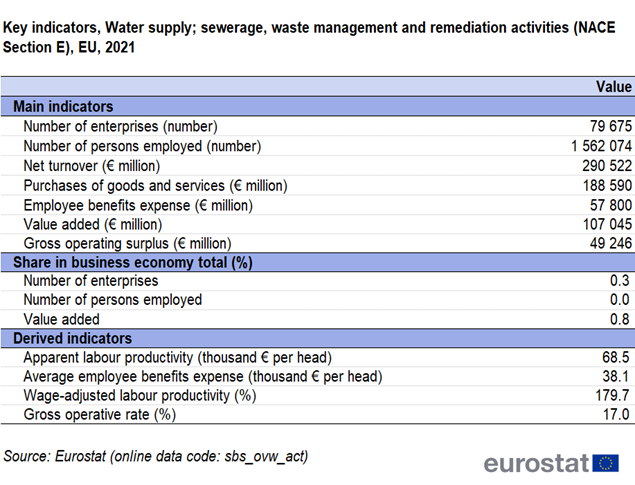
Source: Eurostat (sbs_ovw_act)
The average employee benefits expenses (average personnel costs) within the EU's water supply, sewerage, waste management and remediation activities sector were €38 100 per employee in 2021, a bit lower than the average in the business economy (€39 000). Apparent labour productivity in the water supply, sewerage, waste management and remediation activities sector was €68 500 per person employed, some 14.0 % above the business economy average (€60 200 per person employed). The wage-adjusted labour productivity ratio gives an idea of the extent to which apparent labour productivity relates to average personnel costs. For the EU's water supply, sewerage, waste management and remediation activities sector in 2021 this ratio was 179.7 %; this was well above the business economy average (154.4 %).
Sectoral analysis
In employment terms, waste collection, treatment and disposal activities and materials recovery (Division 38, hereafter referred to as waste and materials recovery) was the largest subsector in the EU, occupying two-thirds (66.6 %) of the employment within the water supply, sewerage, waste management and remediation activities sector in 2021 — see Figure 1. Water collection, treatment and supply (Division 36, hereafter referred to as water supply) contributed to less than one-quarter (21.6 %) of the employment, followed by sewerage activities (Division 37) with 9.6 % and remediation activities and other waste management services (Division 39) with 2.2 %. Waste and materials recovery was the largest subsector in the EU also in value added terms, with 61.7 % of the value added within the water supply, sewerage, waste management and remediation activities sector in 2021.

(% share of sectoral total)
Source: Eurostat (sbs_ovw_act)
In 2021, within the sector of water supply, sewerage, waste management and remediation activities sector, the subsector of materials recovery was the largest subsector in the EU not only in term of employment (1.0 million persons) and value added (€66.0 billion), but also in terms of number of enterprises (48 000 enterprises) and total employee benefits expense (€38.6 billion).

Source: Eurostat (sbs_ovw_act)
The apparent labour productivity varied considerably among the four subsectors, from €61 600 per person employed for remediation activities and other waste management services to 86 700 per person employed for the sewerage subsector.
Average employee benefits expense for the water supply, sewerage, waste management and remediation activities sector was €38 100 per employee in 2021. For the four subsectors, the values for the average employee benefits expense were quite similar, ranging from €35 800 for the water collection, treatment and supply to €42 900 for the sewerage subsector.

Source: Eurostat (sbs_ovw_act)
Country overview
As was the case for electricity, gas, steam and air conditioning supply, the water supply, sewerage, waste management and remediation activities sector contributed a relatively large share of the business economy employment in a number of EU Member States in Central and Eastern Europe.
The water supply, sewerage, waste management and remediation activities sector provided employment to 1.0 % of the business economy persons employed in 2021 in the EU. The highest employment rate was registered in Croatia, where 2.9 % of the persons employed in the business economy were employed in the water supply, sewerage, waste management and remediation activities sector. In Romania and Bulgaria the employment share was 1.9 % and 1.5 %, respectively. On the other side, in Luxembourg and the Netherlands this sector contributed to only 0.4 % of the business economy employment. The water supply, sewerage, waste management and remediation activities sector accounted for a similar share of business economy value added as employment in the majority of the Member States in 2021 (see Figure 2).
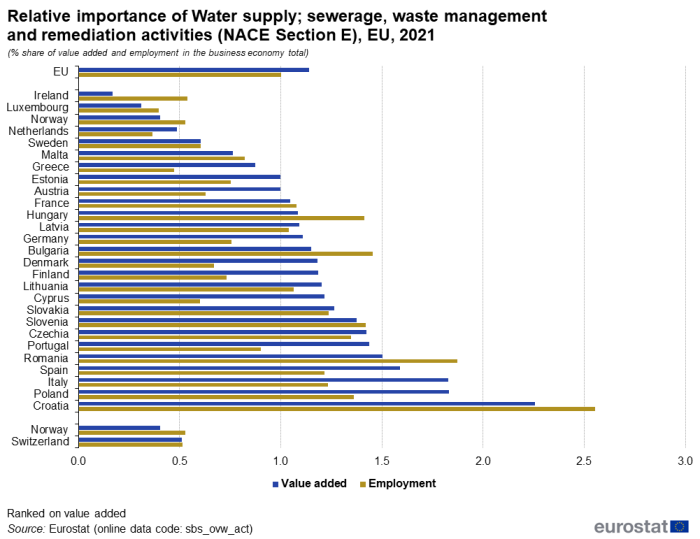
(% share of value added and employment in the business economy total)
Source: Eurostat (sbs_ovw_act)
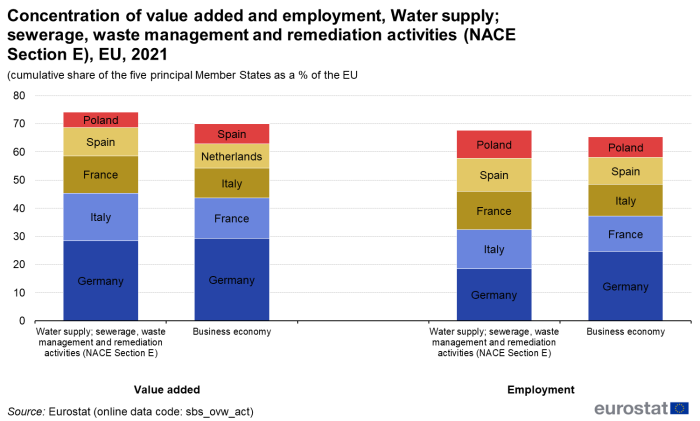
(cumulative share of the five principal Member States as a % of the EU total)
Source: Eurostat (sbs_ovw_act)
Germany had the largest value added for the total of the water supply; sewerage, waste management and remediation activities (30.6 % of the EU total), as well as for all the four subsectors. Table 3 shows that there were a number of country-specific cases of specialisation within the water supply, sewerage, waste management and remediation activities sector. In Croatia this sector contributed 2.3 % of business economy value added in 2021, followed by Poland and Italy, where this share was 1.8 %. Croatia was also most specialised in the waste management and materials recovery sector, which represented 1.6 % of the country's business economy value added and in remediation activities and other waste management services (0.1 %). The water supply subsector was dominated by Portugal (0.7 %), while the sewerage subsector was dominated by Cyprus with 0.6 % of business economy value added.

Source: Eurostat (sbs_ovw_act)
In absolute terms, Germany, Italy and France had the largest number of persons employed in the water supply, sewerage, waste management and remediation activities sector in 2021, each with more than 200 000 persons employed, followed by Spain and Poland with 182 600 and 155 100 persons employed respectively. In terms of value added, Germany had by far the largest water supply, sewerage, waste management and remediation activities sector, generating €30.5 billion, or 28.5 % of overall value added in sector. It was followed by Italy (16.9 %), France (13.3 %), Spain (10.0 %) and Poland (5.6 %).
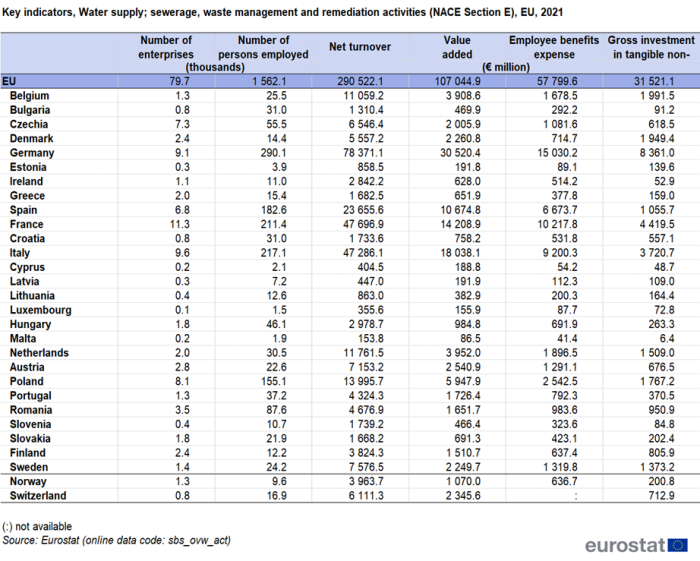
Source: Eurostat (sbs_ovw_act)
These very different levels were reflected in the apparent labour productivity figures, with Germany averaging a value added of €105 200 per person employed and Italy with €83 100, far ahead of the EU average of €68 500 per person employed. However, there were Member States with even higher apparent labour productivity, e.g. Denmark (€157 300 per person employed), Belgium (€153 100 per person employed) and the Netherlands (€129 700 per person employed). The highest wage-adjusted labour productivity ratios with values above 250 % in the water supply, sewerage, waste management and remediation activities sector were recorded in Cyprus (341.2 %), Denmark (295.5 %) and Finland (229.3 %).
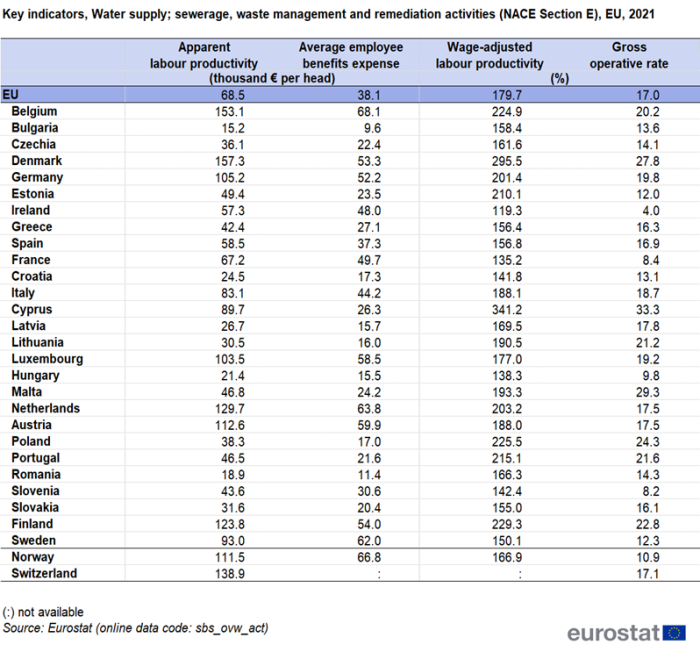
Source: Eurostat (sbs_ovw_act)
Data sources
Coverage
This article presents an overview of statistics for the EU's water supply, sewerage, waste management and remediation activities sector, as covered by NACE Rev. 2 Section E. This NACE section is composed of four NACE divisions, namely:
- water supply (Division 36) which concerns the collection, purification, desalinisation and distribution of water. Some water, particularly when used in production processes, does not come from the public water supply system, but rather is extracted directly from its source. The (typically long distance) transport of water via pipelines is excluded.
- sewerage activities (Division 37) which concern the operation of sewer systems or sewage treatment facilities that collect, treat, and dispose of sewage. Activities of water supply are often carried out in connection with, or by units also engaged in, the treatment of sewerage.
- the management (including collection, treatment and disposal) of other forms of waste (Division 38), whether solid or non-solid waste, industrial or household waste, including the dismantling of wrecks and the operation of materials recovery facilities. Materials recovery includes the processing of metal and non-metal waste and scrap and other articles into secondary raw materials: the processing may involve a number of stages such as separating, sorting, crushing, shredding, cutting, melting, grinding, pressing, stripping, cleaning and composting. The output of the waste or sewage treatment process can either be disposed of or become an input into other production processes. Materials recovery does not extend to the production of new final products, nor does it include wholesaling of recoverable materials. Materials recovery does not cover reprocessing of nuclear fuels. Note also that substantial materials recovery may be carried out by enterprises as ancillary activities, without the involvement of enterprises in the waste management subsector.
- remediation activities (Division 39) such as decontamination.
Data sources
The analysis presented in this article is based on the main dataset for structural business statistics (SBS), size class data and regional data, all of which are published annually. The main series provides information for each EU Member State as well as a number of non-member countries at a detailed level according to the activity classification NACE. Data are available for a wide range of variables. Structural business statistics cover the 'business economy', which includes industry, construction and many services (NACE Rev. 2 sections B to N, P to R as well as division S95 and S96). Structural business statistics do not cover agriculture, forestry and fishing, nor public administration. Structural business statistics describe the business economy through the observation of units engaged in an economic activity; the unit in structural business statistics is generally the enterprise. An enterprise carries out one or more activities, at one or more locations, and it may comprise one or more legal units. Enterprises that are active in more than one economic activity (plus the value added and turnover they generate, the people they employ, and so on) are classified under the NACE heading corresponding to their principal activity; this is normally the one which generates the largest amount of value added.
In structural business statistics, size classes are generally defined by the number of persons employed. A limited set of the standard structural business statistics variables (for example, the number of enterprises, turnover, persons employed and value added) are analysed by size class, mostly down to the three-digit (group) level of NACE. The main size classes used in this article for presenting the results are:
- small and medium-sized enterprises (SMEs): with 1 to 249 persons employed, further divided into:
- micro enterprises: with less than 10 persons employed;
- small enterprises: with 10 to 49 persons employed;
- medium-sized enterprises: with 50 to 249 persons employed;
- large enterprises: with 250 or more persons employed.
Structural business statistics also include regional data. Regional SBS data are available at NUTS levels 1 and 2 for the EU Member States, Iceland and Norway, mostly down to the two-digit (division) level of NACE. The main variable analysed in this article is the number of persons employed. The type of statistical unit used for regional SBS data is normally the local unit, which is an enterprise or part of an enterprise situated in a geographically identified place. Local units are classified into sectors (by NACE) normally according to their own main activity, but in some EU Member States the activity code is assigned on the basis of the principal activity of the enterprise to which the local unit belongs. The main SBS data series are presented at national level only, and for this national data the statistical unit is the enterprise. It is possible for the principal activity of a local unit to differ from that of the enterprise to which it belongs. Hence, national SBS data from the main series are not necessarily directly comparable with national aggregates compiled from regional SBS.
Context
The organisation of water supply within the EU varies between Member States, with state-owned, private and mutual enterprises, as well as municipalities involved in terms of the ownership or operation of infrastructure. Among the key issues that affect this sector are the quality of drinking water, and the efficient use of water resources, the latter concerning issues such as pricing, repair of leakages, metering of water use, and water-efficient practices. Furthermore, the cost of related services (such as wastewater collection and treatment) is an important factor, as is the impact of changes in consumption patterns, for example, the increased use of water related to growth in tourism particularly in areas with scarce water resources.
Adopted in 2000, the Water framework Directive provides the basis for water policy within the EU. This framework directive is built on four main pillars:
- coordinated action to achieve 'good status' for all EU waters, including surface and groundwater, by 2015;
- setting-up a water-management system based on natural river basin districts, crossing regional and national boundaries — at the time of writing most but not all river basin management plans had been adopted;
- integrated water management, bringing different water management issues into one framework;
- active involvement of interested parties and consultation of the public.
In 2006 and early 2007 the European Commission carried out an assessment of water scarcity and droughts in the EU. Based on this, in July 2007 it proposed an initial set of policy options to increase water efficiency and water savings in the form of a Communication addressing the challenge of water scarcity and droughts in the European Union. Seven policy options were identified for tackling water scarcity and drought issues:
- putting the right price tag on water;
- allocating water and water-related funding more efficiently;
- improving drought risk management;
- considering additional water supply infrastructures;
- fostering water efficient technologies and practices;
- fostering the emergence of a water-saving culture;
- improving knowledge and data collection.
In efforts to reduce pollutants discharged into the environment with wastewater, the EU has implemented legislation on 'urban wastewater treatment' (Directive 1991/271/EC). The pollution of rivers, lakes and groundwater and water quality is affected by human activities such as industrial production, household discharges, or arable farming; a report (COM(2007) 120 final) on 'the protection of waters against pollution by nitrates from agricultural sources' was issued in March 2007.
The European Commission adopted in November 2012 its 'Blueprint to safeguard European waters', a new strategy to reinforce water management in the EU. This blueprint integrates the results of a policy review concerning: water scarcity and droughts; an analysis of the implementation of river basin management under the water framework Directive; a review of the vulnerability of environmental resources (such as water, biodiversity and soil) to climate change impacts and man-made pressures; and a review of the whole of the EU's water policy framework in the light of the European Commission's 'better regulation' approach. The blueprint aims to ensure that good quality water is available across Europe in sufficient quantities for all legitimate uses.
Waste
The EU's sixth environment action programme (EAP) runs from 2002 to 2012 and identifies waste prevention and management as one of four top priorities. Its primary objective is to decouple waste generation from economic activity. Work on defining the next programme is underway, with the European Commission adopting a proposal in November 2012 for a 'General Union Environment Action Programme to 2021 — Living well within the limits of our planet' (COM(2012) 710 final). The proposal identifies nine priority objectives:
- to protect, conserve and enhance the EU's natural capital;
- to turn the EU into a resource-efficient, green and competitive low-carbon economy;
- to safeguard the EU's citizens from environment-related pressures and risks to health and wellbeing;
- to maximise the benefits of the EU's environment legislation;
- to improve the evidence base for environment policy;
- to secure investment for environment and climate policy and get the prices right;
- to improve environmental integration and policy coherence;
- to enhance the sustainability of the EU's cities;
- to increase the EU's effectiveness in confronting regional and global environmental challenges.
In November 2008, a Waste framework Directive was adopted which introduces a binding five-step waste hierarchy, whereby prevention is the preferred option, followed by re-use, recycling and other forms of recovery, with disposal such as landfill used only as a last resort. Unless properly regulated, the disposal of waste may have a serious environmental impact: landfills, for example, can take up land space and may cause air, water and soil pollution, while incineration can result in emissions of dangerous air pollutants.
EU policy aims to move waste management up the waste hierarchy taking into account environmental impacts over the entire life cycle. Waste prevention can be achieved through cleaner technologies, better design, or more efficient production and consumption patterns; as well as reducing waste these preventative actions may lead to reductions in resource consumption throughout production and distribution chains.
EU legislation sets binding targets for Member States on the recovery and recycling/re-use of municipal waste, batteries, electrical and electronic waste, construction and demolition waste, end-of-life vehicles and packaging.
Direct access to
Structural business statistics introduced
More detailed analysis of water supply; sewerage, waste management and remediation activities:
- Recent Eurostat publications on SBS
- Key figures on Europe – 2023 edition – see subchapter on Business
- Eurostat's Regional Yearbook – see chapter 8. Business
- News Release SBS – 2021 final data
Glossary
ESMS metadata files
- Structural business statistics – SBS metadata file